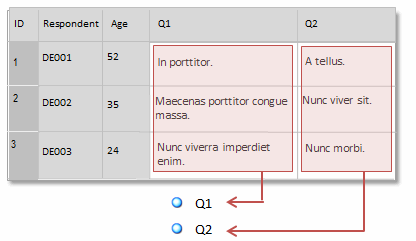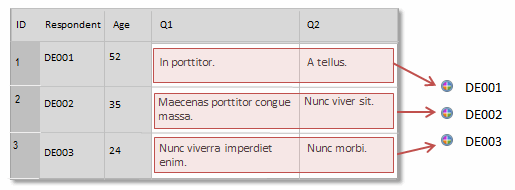|
|
Automatic coding in dataset sources
You can use auto coding to organize dataset content into case nodes or theme nodes for further exploration. This topic explains how auto coding works in different types of datasets and explains how to get started with the Auto Code Assistant.
What do you want to do?
- Watch the videos
- Understand automatic coding in datasets
- Auto code a dataset at nodes for selected columns
- Auto code and classify a dataset at cases for each value in a column
- Auto code a social media dataset based on predefined columns
Watch the videos
Understand automatic coding in datasets
A dataset contains structured data arranged in records (rows) and fields (columns). Datasets can contain classifying columns and codable columns. You can use the Auto Code Assistant to code content of codable columns.
You can auto code based on the rows or columns in your dataset. You can choose to:
-
Code at nodes for selected columns
For example, If you have imported survey results from a spreadsheet, you can auto code to gather all the responses for each question.
The image below shows a dataset containing survey responses to two questions. With auto coding, you can create a theme node (Q1 and Q2) for each question. The responses to each question are automatically coded at the relevant node.

Refer to Auto code a dataset at theme nodes for selected columns for detailed instructions.
-
Code at cases for each value in a column
For example, if your dataset contains survey results, you can auto code to gather everything a particular respondent has said.
In the image below, a case node is created for each respondent (DE001, DE002, and DE003) and the responses are coded at the relevant case.

If you have collected demographic information about the survey respondents, you can optionally automatically classify the cases that are created. This will add the demographic information—for example, age and gender—contained in the classifying columns
Refer to Auto code and classify a dataset at cases for each value in a column for detailed instructions.
Auto code a dataset at nodes for selected columns
-
In List View or Detail View, click on the dataset you want to auto code.
-
On the Analyze tab, in the Coding group, click Auto Code.

The Auto Code Assistant opens. Follow the steps on the Assistant.
| Assistant step | Description |
|
Choose how you would like to code at nodes |
Choose Code at nodes for selected columns to create and code at nodes based on the columns in the dataset. For example, you can create a theme node for all Question 1 responses, and another node for all Question 2 responses. |
|
Select the columns you want to create as nodes. |
Select the columns that you want to create nodes for. All the codable columns are selected by default. You can remove a column—click a column in the Selected columns list and then click the left arrow < to move it to the Available columns list. The preview area shows the nodes that will be created based on the options you have selected (you can choose a location for the nodes in the next step). |
|
Select a location for the nodes. |
You can store the nodes under a new node or under an existing parent node. The preview area shows the node structures that will be created. |
NOTE For filtered datasets, all the rows are coded.
Auto code and classify a dataset at cases for each value in a column
To auto code and classify a dataset at cases for each value in a column.
-
In List View or Detail View, click on the dataset you want to auto code.
-
On the Analyze tab, in the Coding group, click Auto Code.

The Auto Code Assistant opens. Follow the steps on the Assistant.
| Assistant step | Description |
|
Choose how you would like to code at cases |
Choose Code at cases for each value in a column to create and code at cases based on the values in the columns of the dataset. For example, you could create and code at a case for each respondent in your survey. |
|
Select the columns that contain values you want to use as case names |
Select the column that contains the names of your cases—these are the cases that will contain the coded content. For example, if you want to create a case node to represent each person you surveyed, you could select the column which contains their name or some other identifier. You should ensure that each cell in this column contains a different value. If two people share the same name, only a single case node will be created. The preview area shows the cases that will be created based on the options you have selected. |
|
Select a location for the cases and classify the cases |
You can store the cases under a new case or under an existing parent case. Decide whether you want to turn on aggregation for parent nodes—if you select this option, then all the content coded at the children is shown in the parent node. Refer to Aggregate nodes for more information. Choose Classify cases from classifying columns if you want to create cases that include classifying information—for example, Age or Gender. When you choose this option, you can either create a new classification or add to an existing classification. If you choose to classify cases from classifying columns and also to store the cases under an existing parent case, it is possible that the new cases you are creating match existing case names. In this situation, you can select the Update classification and attribute value assignment of existing cases check box which assign new classification and attribute values based on the data from the classifying columns. If you do not want to change the classification and attribute values for existing case nodes, then clear the check box. |
NOTE For filtered datasets, all the rows are coded.
Auto code a social media dataset based on predefined columns
-
In List View or Detail View, click on the dataset you want to auto code.
-
On the Analyze tab, in the Coding group, click Auto Code.

The Auto Code Wizard opens. Follow the steps on the Wizard.
| Wizard step | Description |
|
Choose how you would like to code at nodes |
Choose Code at nodes for each value in predefined columns This option is only available for datasets containing social media data (for example, Facebook or Twitter) collected with NCapture. |
|
Select the predefined columns that contain values you want to use as node names |
Choose how you want to code the posts or comments. The options available will vary depending on the type of social media data. For example, if you are coding a dataset containing Facebook data, you can select Conversation. The content of a post and its comments will be coded to a node for the conversation. This helps to see the context of the comments. If you auto code by Username, a case node is created for each user and their profile information—for example, Gender and Location—is stored as attribute values on their node. The preview area shows the nodes that will be created based on the options you have selected. |
|
Select a location for the nodes. |
You can store the nodes under a parent node. If you want to code at nodes that already exist in your project, you must select the location that matches the existing hierarchy. If you select a different location, new nodes will be created. |
NOTE For filtered datasets, all the rows are coded.



